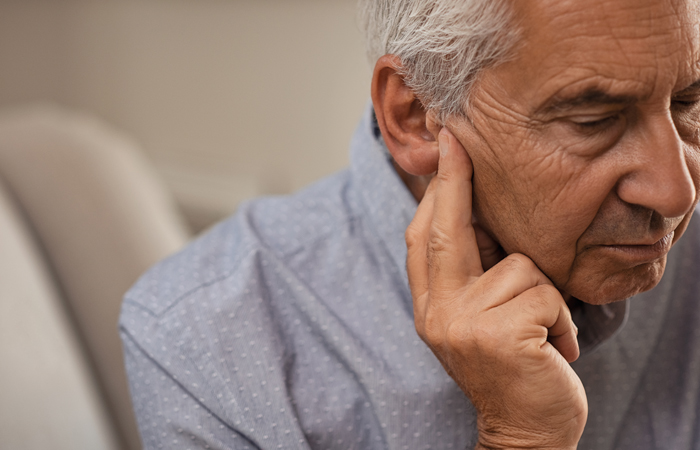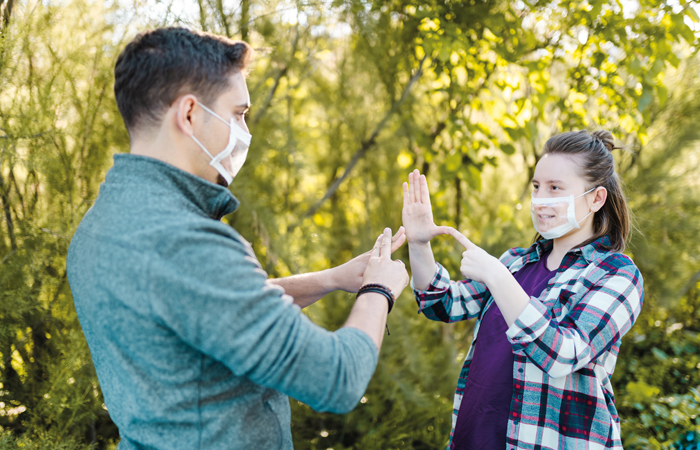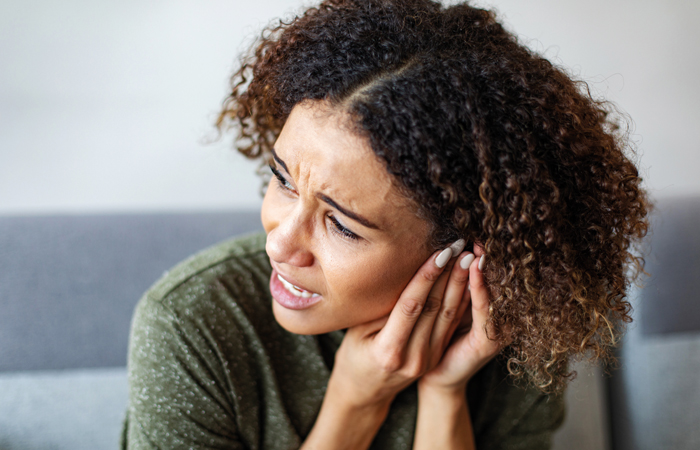The deafening silence of ear problems
In OTC
Follow this topic
Bookmark
Record learning outcomes
The social and mental impact of hearing loss can be devastating and isolating, but pharmacy teams have the opportunity to improve accessibility within the pharmacy and provide support
Although the festive period may be a little different this year, families will still be able to get together to celebrate. For many, this is exciting news, but for those who are Deaf or have hearing difficulties, coming together in groups can bring with it a unique set of challenges that need considering.

On top of this, the impact of the Covid-19 pandemic has contributed to feelings of isolation and loneliness among many people in the Deaf community. According to a survey conducted between August and September 2020 by the Deaf health charity SignHealth, the biggest issues caused by the pandemic are social isolation (79 per cent), face masks (62 per cent) and lack of access to healthcare (56 per cent).
But community pharmacy teams have the opportunity to tackle isolation, improve accessibility within the pharmacy – especially with some exciting new technology that has emerged – and signpost customers to further support. In addition, pharmacy teams can help people manage common ear conditions that can flare up, easing the pain and irritation they may cause.
Isolation and the mental impact
There are approximately 12 million people with some form of hearing loss across the UK, which is expected to increase to 15.6 million by 2035, according to research from the Royal National Institute for Deaf People (RNID).
Hearing loss can cause people to withdraw from daunting social situations, which can lead to further emotional distress, depression and increase risks of loneliness. “Particularly at this time of year in the run up to Christmas, there is a lot of talk in the Deaf community about dinner table issues,” says James Watson-O’Neill, chief executive of SignHealth. “It’s quite common if you’re in a slightly larger than normal family setting that the Deaf person might start to get left out of a conversation. There’ll be a joke that is shared that they don’t quite catch, and it can be quite hard to keep up.”
Similarly, this situation can be translated into other settings, such as the pharmacy. “Deaf people will choose to step out of that conversation rather than try to stay in it,” says James. “When people see that start to happen, I would encourage family members, or pharmacy teams – whoever is in contact – just to make the effort to bring that Deaf person back into the conversation.”
In addition to feelings of isolation, people with hearing loss are more likely to experience mental health problems, have increased anxiety about their personal safety and have trouble sleeping. “Unfortunately, loneliness and isolation can lead to depression – hearing loss doubles the risk of developing depression,” says Francesca Oliver, audiology specialist at the RNID. And, according to the SignHealth survey, more than one in three Deaf people reported that the pandemic has had a major negative impact on their mental health.
Those struggling can find online mental health support, including free text services, on the RNID website.
Some 74 per cent of Deaf survey respondents found it more difficult during the pandemic to access healthcare
Increasing accessibility
Some 74 per cent of Deaf survey respondents found it more difficult during the pandemic to access healthcare and 36 per cent had trouble accessing medication, according to an additional survey conducted by SignHealth in October 2020.
So, what can pharmacy teams do to help? There are some easy changes that can be made in the pharmacy to make things more accessible for people with hearing loss and provide solutions for them to tackle isolation, loneliness and mental health issues.
“Quite often we see medical information is passed between Deaf people and healthcare professionals in written notes,” explains James. “That happens too often, and that is in a Deaf person’s second language if they are a first language British Sign Language (BSL) user.”
In response to the pandemic, SignHealth has launched a new service that can be used within pharmacies and other healthcare settings. BSL Health Access offers free, on-demand remote video interpreting, allowing for two-way access to communication between Deaf BSL users and healthcare professionals. And it is easily accessible within a pharmacy on an internet-enabled tablet or smartphone. James says: “Enabling the Deaf sign language user to have the conversation in their first language is really important.”
Pharmacy teams can also access and signpost customers to SignHealth’s Health Video Library, which includes specific medical terminology and information in BSL, to aid conversations in a healthcare setting. “If somebody is speaking to a patient about heart disease or contraception for example, there’ll be a video in our library that may be able to help them in sign language,” says James.

Pharmacy teams can also adopt some of the RNID’s recommended tips for communicating with Deaf people, or others with hearing difficulties, in a pharmacy setting. Where lipreading is possible, these include:
- Ensuring there is adequate lighting
- Facing the person
- Getting the person’s attention before speaking
- Using normal lip movements, facial expression and gestures.
Where lip reading isn’t possible, such as during a phone call or when wearing PPE, these tips include:
- Speaking clearly, but not shouting or speaking unnecessarily slowly
- Finding an alternative way of saying something if someone does not understand
- Checking understanding by asking the person to repeat information back
- Using plain language and being straight to the point
- Reducing background noise as much as possible
- Providing written information, where possible or necessary
- If requested, speaking to a relative or friend.
Masking the issue
Face masks and social distancing have contributed to feelings of isolation for people with hearing loss. “It is very difficult to overstate how big of an impact it has had. For us as Deaf people, being able to see somebody’s face is a really important part of communication, whether you are communicating in sign language or not,” says James Watson-O’Neill, chief executive of Deaf health charity SignHealth.
The Royal National Institute for Deaf People (RNID) is calling on the Government to raise awareness of the challenges faced by Deaf people and people with hearing loss when communicating with face coverings and provide clarity on improving the options that are safe and available, such as alternative face masks. “The Department of Health and Social Care has approved a mask with a clear panel to enable access to visual cues such as facial expression and lipreading, for use in some settings as PPE,” says Francesca Oliver, audiology specialist at the RNID.
Face masks have caused additional problems with the placement of cochlear implants and hearing aids. The RNID has created a video on how to wear a face covering for those affected, which can be viewed on Youtube.

Common ear complaints
Customers can also find support for a whole range of common ear problems in the pharmacy, including self care tips and product recommendations
Earwax
Also known as cerumen, earwax is a substance that is produced in order to protect the ear canal from infection and keep it lubricated. Often yellow or brown in colour, earwax should naturally fall out of the ear, but sometimes a build-up can occur. This is quite common, with approximately 2.3 million people every year in the UK having problems with impacted earwax and needing intervention.
A build up can occur for several reasons, including:
- Naturally producing more earwax
- Having narrow ear canals
- Ageing – wax gets harder as people get older, making it more difficult for it to fall out
- Putting things in the ear such as hearing aids and earplugs.
The excess wax may cause hearing difficulties, earache, itchiness, dizziness and even an ear infection.
Pharmacy teams can recommend ear drops to try and help soften earwax. “The National Institute for Health and Care Excellence (NICE) does not recommend specific ear drops to manage wax as there is little evidence to suggest which is most effective,” explains Francesca. “However, using room temperature olive oil drops for three to five days is recommended by many clinicians to help soften wax before removal.”
If there continues to be a blockage, customers should be referred to a GP or specialist private clinic, where appropriate, for further intervention. “It’s always a good idea to remind people that they should never insert anything into their ears that’s smaller than their elbow. Ears are self-cleaning and wax should only ever be removed by a trained professional,” says Francesca.
2.3 million people every year in the UK have problems with earwax
Earache
Earache is a common condition, particularly in children. It is often caused by a minor ear infection and usually clears up on its own without treatment.
It is characterised by an infrequent or constant, sharp or dull, burning pain in the ear, and one or both ears may be affected.
Pharmacy teams can suggest customers use paracetamol or ibuprofen to manage any pain. Ear drops can be recommended, if suitable, but these will not treat an ear infection. Placing a warm or cold flannel against the ear can help ease pain, but customers should avoid getting the inside of the ear wet.
Glue ear
Glue ear is very common in children, with eight out of 10 children thought to experience glue ear before the age of 10, according to the National Deaf Children’s Society.
The condition can also affect adults and is caused by a build-up of thick and sticky fluid in the middle ear behind the eardrum. This can cause issues with hearing and balance. Glue ear can be caused by a cold or flu, allergies, passive smoking and it has also been linked to ear infections.
It usually clears up on its own within three months. Children may be monitored for up to a year and receive further treatment from a GP if symptoms change or worsen.
Otitis media
This describes infection and inflammation within the middle ear, including the eardrum and the small space behind it.
Symptoms of acute otitis media usually develop quickly and can include earache, sickness, partial hearing loss, fever and lack of energy. Sometimes the eardrum may also perforate. If this occurs, it is important for customers to try and keep their ear dry for the next six weeks.
Most infections clear up within three to five days without treatment, but pharmacy teams can recommend paracetamol or ibuprofen for pain and fever management. Antibiotics may be prescribed in severe cases, or if symptoms persist for longer than three days. Pharmacy teams can also recommend placing a warm or cold flannel on the ear and removing any discharge with cotton wool.

Otitis externa
This ear infection causes redness and swelling in the external ear, which is the canal between the eardrum and auricle – the outermost part of the ear.
Otitis externa is usually caused by a bacterial infection, although other causes can include irritation, fungal infection and allergies. The condition is often known as swimmers’ ear because repeated exposure to water can make the ear canal more susceptible to infection.
Symptoms include severe ear pain, itchiness, partial hearing loss and discharge from the ear, and usually only one ear is affected.
Pharmacy teams can recommend customers keep their ear dry by avoiding swimming and wearing a shower cap in the shower. Customers should try to avoid earplugs and other things that may cause irritation.
Tinnitus
Approximately 30 per cent of people will experience tinnitus at some point in their lives, but the number of people who live with persistent tinnitus is approximately one in eight (13 per cent), according to the British Tinnitus Association (BTA).
Tinnitus describes the sensation of hearing noises without external factors creating them. Symptoms can include hearing a variety of sounds including ringing, buzzing, humming or whooshing in the ear. These sounds can be continuous or infrequent and feel like they are in one or both ears and even inside the head.
Tinnitus can be caused by a wide ranging variety of causes, including some forms of hearing loss, ear damage caused by exposure to loud noises and earwax build-up. “If any underling conditions are identified – such as earwax, ear infections and high blood pressure – then treating these conditions may improve tinnitus,” says Tony Kay, president of the BTA.
"First line management includes reassurance that tinnitus is common, and that it may resolve by itself. It is commonly associated with hearing loss but not commonly associated with other underlying conditions. However, whilst serious underlying conditions are rare, it’s wise to signpost a person complaining of tinnitus to their GP for assessment, ear examination, and referral into ENT/Audiology services for further assessment, hearing tests and management when appropriate," he adds.
Pharmacy teams can suggest some self care tips to help manage symptoms, and Tony recommends:
- Hearing aids, which can be of benefit if there is hearing loss
- Managing stress, anxiety and low mood
- Practising relaxation techniques, using background sound to distract and relax
- Wearing ear protection when exposed to excessive noise
- Attending local and online tinnitus support groups.
